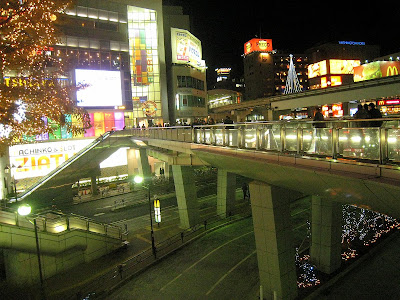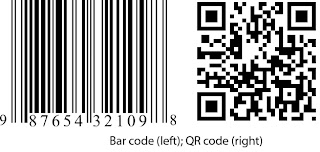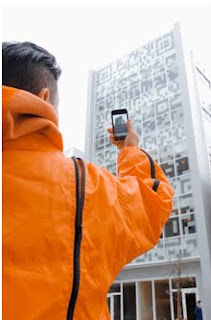Reading a Building with your iPhone (original) (raw)
?? N Building from Alexander Reeder on Vimeo.
The idea of using symbolism and signage is a constant one in the history of architecture. The Gothic church, the fa�ade at Amiens or Rouen, it is a three-dimensional billboard. The Sphinx in ancient Egypt had a great meaning independent of art. At the time, most of people couldn't read. - Robert Venturi
Wherever technology reaches its real fulfillment, it transcends into architecture . . . Architecture is the real battleground of the spirit . . . It is the crystallization of its inner structure, the slow unfolding of its form. That is the reason why technology and architecture are so closely related. Our real hope is that they will grow together, that some day the one will be the expression of the other. Only then will we have an architecture worthy of its name: architecture as a true symbol of our time. - Mies van der Rohe
To Robert Venturi, structure is like a skeleton. Architecture isn't complete until it's fleshed out. To Mies, structure is architecture. It's reality reduced to its spiritual essence.
Perhaps, however, the greatest power of architecture is to reconcile the irreconcilable, and it's hard to think of a better expression of this than Tokyo's N Building, a collaboration between Teradadesign Architects and Qosmo Inc.
The building, itself, is fairly unremarkable. What's extraordinary is the facade. The
N Building is near the monorail station in the city's Tachikawa district, which is replete with the usual cacophonic blare of Times Square-like signage, seen in this photo from the Pleasure Fruits blog. 
For N Building, Qosmos CEO Nao Tokui sought out an alternative:
Being a commercial building, signs or billboards are typically attached to its facade, which we feel undermines the structures� identity. As a solution we thought to use a QR Code (two-dimensional bar code) as the facade itself.
QR (Quick Response) Codes, were created in 1994 by Denso, a Japanese manufacturer of auto components,  originally to track parts during the manufacturing process. QR Code is a matrix type of bar code. We're all familiar with traditional one dimensional bar codes, which express information in a linear strip of bars of varying width. QR Codes take this into the second dimension. A linear bar code may accommodate 128 characters; a 2D QR Code, as many as 7,089. Here's an ad from DoCoMo Japan demonstrating on how QR Codes work (and how they'll let you land and keep your man.)
originally to track parts during the manufacturing process. QR Code is a matrix type of bar code. We're all familiar with traditional one dimensional bar codes, which express information in a linear strip of bars of varying width. QR Codes take this into the second dimension. A linear bar code may accommodate 128 characters; a 2D QR Code, as many as 7,089. Here's an ad from DoCoMo Japan demonstrating on how QR Codes work (and how they'll let you land and keep your man.)
You can see a far more prosaic, and much more informative, demo here.
While QR Codes have been slow to catch on in the U.S., that appears to be changing. In San Francisco in 2008, more than 500 restaurants signed up for a QR Code test. That same year, Ralph Lauren included QR codes in its ads for the US Open. According to a recent article by Christina Warren on the Mashable Social Media Guide, Google has sent out 190,000 QR stickers to local retailers, which they can place on windows or around their stores where patrons can scan them with their cell phones for ready access to the retailer's Places page on Google. As could be expected, Microsoft has created its own proprietary version of QR Codes the Microsoft Tag. QR code reader apps are available for the iPhone, the Android, and through service providers such as Sprint.  The actual design of QR Codes has gone far beyond the functional, with firms such as Set Japan embedding codes in the type of artwork you see here, for clients as upscale as Louis Vuitton, seen at the right in set of images above. QR Code has been become an inspiration for everything from street art to surfboards. In architecture, QR Codes can be applied symbolically, as in Vienna's Söhne & Partner's design for a
The actual design of QR Codes has gone far beyond the functional, with firms such as Set Japan embedding codes in the type of artwork you see here, for clients as upscale as Louis Vuitton, seen at the right in set of images above. QR Code has been become an inspiration for everything from street art to surfboards. In architecture, QR Codes can be applied symbolically, as in Vienna's Söhne & Partner's design for a  Code Unique Hotel for Dubai's Studio City. Prophetically - and ironically - the firm has described Dubai as "the next Mecca of the global illusions industry." The use of QR code appears to poetic - and fixed:
Code Unique Hotel for Dubai's Studio City. Prophetically - and ironically - the firm has described Dubai as "the next Mecca of the global illusions industry." The use of QR code appears to poetic - and fixed:
The facade gives the hotel the name, it is not only an eyecatcher - the implication of the facade structure is a code - a special matrix code to be named - QR Code . . . There is a massage behind the code - but who knows it? Take your mobile and decode it!
Teradadesign and Qosmo's N Building is more dynamic, using a dedicated iPhone app to "read" the building:
Our proposed vision of the future is one where the facade of the building disappears, showing those inside who want to be seen. As you press on the characters their comments made on online appear in speech bubbles. You can also browse shop information, make reservations and download coupons.
Rather than broadly tagging, we display information specific to the building in a manner in which the virtual (iPhone) serves to enhance the physical (N Building). Our goal is to provide an incentive to visit the space and a virtual connection to space without necessarily being present. The building is detected in real time by its shape. Characters are then superimposed over the live video.
Twitter feed comments are located via GPS tagging. Store information, reservations and other infrastructure is part of the iPhone application . . .
As explained by Qosmo designer Alexander Reeder, who also creates interactive garments and perfume,
The QR code is part of the facade/wall itself, and thus is static. It is printed on the glass, sandwiched between two layers.
We bring it to life when viewed through a device such as the iPhone.
What is shown on the iPhone changes depending on the occupants in the building. Currently, information displayed is based on location based twitter feeds, but the possibilities are endless.
Despite what the commercial photographers might tell you, architecture is seldom complete without the people a building was designed to serve. Through their actions and alterations, through their very presence, people modify a structure's design. Louis Kahn once famously created a dialogue in which a brick was asked what it wanted to be. And while it's likely that commercial options will soon crowd out all others (one can imagine how QR codes might be deployed, say, in Amsterdam's Red Light District), Teradadesign and Qosmo poses - and proposes to answer - an intriguing, Kahn-like query of inhabitated structure as it evolves through time and use: what is this building thinking?
Join a discussion on this story.
© 2010 Lynn Becker All rights reserved.